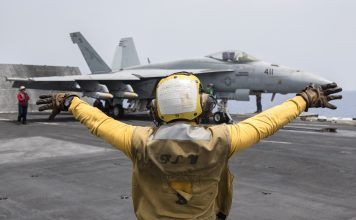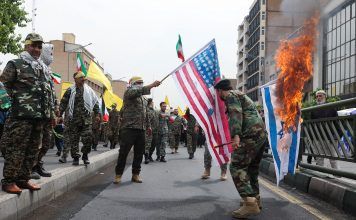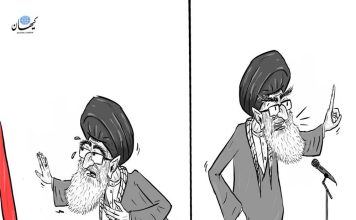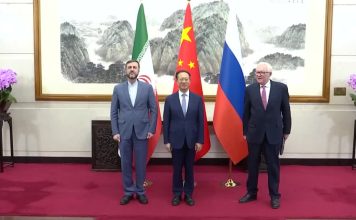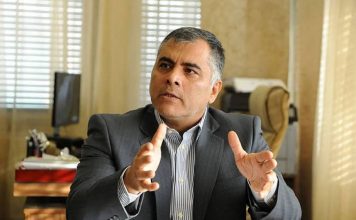By Kayhan Life Staff
Sept. 16 marked the second anniversary of the Iranian government’s killing of Mahsa (Zhina) Amini, an event that ignited widespread protests and evolved into a national movement in 2022. Over the past two years, the popular resistance against the Islamic Republic has remained strong.
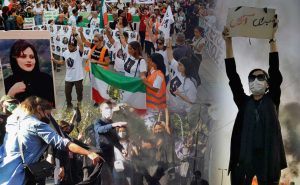
Despite the severe crackdown on street demonstrations, people remain determined to show their unity and opposition to the Iranian government through different means.
Two years ago, after suffering severe treatment from the Morality Police officers, 22-year-old Mahsa spent several days in a coma in the ICU ward of Kasra Hospital in Tehran before ultimately dying from her injuries.
Mahsa’s death on the evening of Sept. 16, 2022, sparked unprecedented protests that unsettled the Iranian government. While similar demonstrations had occurred in previous years, such as in December 2017 and October 2018, the events of 2022 possessed distinct features that captured global attention toward Iran.
Turn Sound on 🔊- Sept. 15 – On the second anniversary of Mahsa Jina Amini’s national uprising, Iranian protesters assembled in Hamburg, Germany to honor the occasion.
Video by X (formerly Twitter) user: @Maryeshgh110
.#kayhanlife #womanlifefreedom #globalrally #mahsaamini… pic.twitter.com/1CV4wLAyBH— Kayhan Life (@KayhanLife) September 16, 2024
These demonstrations articulated and solidified the long-simmering frustration of a nation encompassing individuals of all races, languages, income levels, and educational backgrounds. People across various cities and provinces in Iran spontaneously took to the streets without prior organization in a matter of days. Despite attempts by certain groups to categorize the widespread protests as merely “ethnic” or “tribal,” the protesters stood firm against the bullets and repression imposed by the Islamic Republic. They refused to let their national revolution be misdirected, uniting under slogans that underscored their determination and solidarity from Kurdistan (west) to Tabriz (northwest) and from Zahedan (southeast) to Tehran (north).
Turn Sound on 🔊- Sept. 16, 2024 Reposted from @sepposley: Mahsa Amini. Dearest daughter of Iran. Forever in our hearts you remain. You, whose innocence and light was so heinously put out, yet became the spark that ignited the flames of freedom. May you be dancing and singing… pic.twitter.com/MkwFJYmSlR — Kayhan Life (@KayhanLife) September 16, 2024
According to the arrest data, individuals who came onto the streets did not belong to any specific income class, social class, ethnicity, language group, or gender. Demonstrators gathered in over 100 cities across Iran, united by a common identity of “Iran” and a shared aspiration for “freedom.”
The Islamic Republic faced a more significant threat of collapse compared to previous protests and could not suppress the protests within a few days, as it had done before. As a result, it launched an unprecedented and severe crackdown on the protesters.
In a show of solidarity, Iranian women protested the tragic arrest and killing of Mahsa, a victim of the “mandatory hijab.” The act of burning scarves in Iranian streets emerged as one of the most significant protests globally in the past fifty years. During these demonstrations, women specifically targeted a critical ideological pillar and a prominent symbol of the Islamic Republic, i.e., the mandatory hijab rule.
This movement represented a manifestation of Iranian national identity among the populace, successfully uniting them and fostering their determination to occupy the streets persistently in pursuit of their goal: liberating Iran from the oppressive regime of the Islamic Republic.
The protests associated with the 2022 national movement will undoubtedly be a significant chapter in the nation’s history. They will be viewed as a pivotal moment in the ongoing struggle against the Islamic Republic.
The level of repression faced by citizens during these protests was unprecedented, more shocking and complex than in previous instances. This included the killing of children and teenagers, targeted shootings that struck young people’s bodies and eyes, incidents of rape and sexual assault against detainees, and the sentencing of many protesting citizens to death through fabricated cases orchestrated by security institutions.
Such widespread repression marked a severe response to this substantial movement. The Islamic Republic’s desire for repression remains unchanged even after two years, as the persecution of protesting citizens continues through imprisonment, harassment, and threats.
On Sept. 10, news emerged regarding the death of Sara Deldar, who had been arrested in Rasht, the capital of the northern province of Gilan. She spent a year and a half in prison with many bullets lodged in her body and ultimately succumbed to an infection resulting from those injuries.
The Islamic Republic stands out among authoritarian regimes by exerting significant pressure on families of protest victims. While this pressure has its origins in the 1980s, a notable instance is that of the family of Pouya Bakhtiari, who was shot in the head by government agents during the November 2019 protests in Karaj (42 kilometers northwest of Tehran). This case exemplifies the repression faced by families seeking justice for their loved ones.
The Islamic Republic has also imposed considerable pressure on grieving families of those who died in the 2019 protests as they demand accountability for their loved ones. As time has passed, many mothers, fathers, sisters, and brothers of those who lost their lives during protests in Iran have emerged as symbols of resilience in their quest for justice and have become vital participants in the national movement.
Meanwhile, Islamic Republic lobbyists and agents sent overseas have been attempting to undermine the atmosphere of empathy and solidarity among Iranians living abroad.
Over the past two years, the regime has struggled to enforce mandatory hijab laws for women. Despite efforts to re-establish these laws and the return of the Morality Police to suppress women and girls through various means, including the nationwide ‘Noor Project,’ Iranian women have shown strong civil resistance. They have actively chosen how to cover themselves and have normalized their choices, achieving significant victories in their struggle for freedom against the Islamic Republic.
The Noor Project is just one component of a broader strategy for enforcing the mandatory hejab (Islamic dress code) in the Islamic Republic. Concurrently, another initiative, the Hejab and Chastity Scheme, is being piloted. These initiatives have provided a platform for elements within the regime to target and intimidate women and girls in public spaces, such as streets and alleyways. They also absorb a colossal proportion of the government budget and of the country’s resources.
On September 15, 2024, Iranian demonstrators gathered in London, UK, to participate in the Global Rallies for Woman, Life, Freedom, marking the second anniversary of Mahsa Jina Amini’s death in Iran.
.#kayhanlife #womanlifefreedom #zanzedegiazadi #mahsaamini #freeiran pic.twitter.com/31t9xuvKGJ— Kayhan Life (@KayhanLife) September 16, 2024
Conversely, citizens have conveyed a strong message to the regime by boycotting the Majlis (Iranian Parliament) and presidential elections – despite tactics such as the potential return of “reformists” or ex-leaders such as former Foreign Minister Mohammad Javad Zarif.
The Iranian people achieved a historic milestone during Nowruz 1403 (the Iranian New Year starting on March 21, 2024) by visiting the ancient site of Persepolis, which served as the ceremonial capital of the Achaemenid Empire, in the southwestern province of Fars. They also visited sites associated with the Pahlavi era (1925-1979), such as the Saad Abad Complex in Shemiranat, Greater Tehran. These visits were spontaneous and not prearranged.
The government has escalated repressive measures aimed at “survival at any cost.” This situation has prompted Iran’s Supreme Leader Ali Khamenei to tighten his control over the government’s executive branches with loyalist forces to further oppress the populace.
Following the suspicious helicopter crash that resulted in the death of former President Seyed Ebrahim Raisi on May 19, Khamenei made efforts to mend his fractured government to present a semblance of unity within the Islamic system. After three decades of escalating tensions, the internal divisions within the ruling faction came to a head during the recent 12th Majlis election.
The conservative faction experienced such discord that, in their bid to secure more parliamentary seats, they began publicly discrediting one another and revealing instances of corruption among their ranks.
Khamenei, while simultaneously attempting to engage in covert negotiations with Western nations through President Raisi’s administration, found himself at the center of a government where factions were in conflict following the loss of Raisi and his Foreign Minister Hossein Amir-Abdollahian, both of whom died in the same helicopter crash.
The turmoil was compounded by increasingly strained foreign relations, leading to disillusionment regarding the prospects of lifting sanctions and generating oil revenue. In this context, Khamenei facilitated the marginalization of reformists and, in collaboration with them, appointed President Massoud Pezeshkian’s government, which comprised handpicked ministers from his inner circle, to address the internal discord within the system.
The present administration, composed of a coalition of various state factions, has exhibited frailty and weakness in governing the nation since its inception. It has resorted to using the National Development Fund to cover the smallest government expenditures.
Iran’s National Development Fund (NDFI), which was established in 2011, is the country’s sovereign wealth fund, supplementing the Oil Stabilization Fund.



